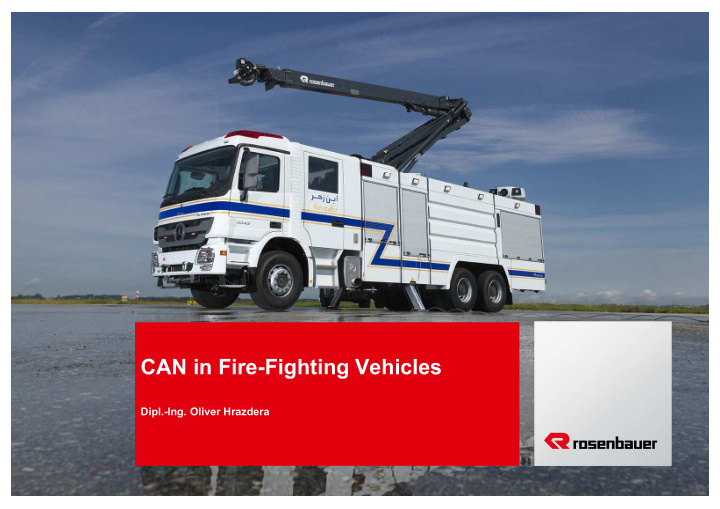



CAN in Fire�Fighting Vehicles Dipl.�Ing. Oliver Hrazdera
Table of content ■ Market situation ■ Special challenges in fire�fighting business ■ Typically parts of a vehicle ■ Chassis (Series�Chassis, Inhouse�Chassis) ■ Superstructure ■ Typically Electronic architecture of a municipal vehicle ■ Controls ■ DIN 14700 ■ Safety according EN 13849 ■ Limits of current CAN systems Folie 2
Market situation ■ Shrinking market ■ 17.000 vehicles per year worldwide ■ Small manufacturers in every country (3100 worldwide) ■ Biggest 3 manufacturers (volume of sales 2014): ■ Rosenbauer 740 Mio€ ■ Oshkosh 530 Mio€ ■ Morita 280 Mio€ ■ The biggest 5 companies are making > 60 % of worldwide sales Folie 3
Challenges for fire�fighting vehicles ■ Small market ■ Every vehicle is different (variance) ■ Different standards for every region/country worldwide ■ High tech versus simple technologie (wide technologie span) ■ 25 years vehicle life span at the first customer ■ Spare part availability (specially in electronics) Folie 4
Series�Chassis ■ Different Chassis with non�standardized interface to the superstructure for following signals (example) ■ Engine speed ■ PTO Non�standardized CAN Protocoll ■ Break signal Chassiscontroller of superstructure ■ Light signals manufacturer ■ Vehicle speed ■ A.s.o. ■ This is currently a bad situation with many incompatibilities and costs on this interface Folie 5
Inhouse�Chassis ■ Small amounts ■ High costs for test and homologation Chassis 8x8 , 52 tons, 130km/h 2 engines – each 800 HP ■ Series parts like engine, transmission (non�change�able) has to be integrated in a vehicle ■ Euro 5/6 filters are not effective, because engine will not become hot ■ Safe Integration of ~ 15 SAE J1939 electronic units Folie 6
Superstructure ■ Typical position of main controllers Folie 7
Electronic architecture of a municipal vehicle (simple version�superstructure) Cab Pump Compartment Body Folie 8
Controls ■ Different complexity of controls according market and customer „simple“ controls Flexible „medium “ controls „high end“ controls over display Push�buttons over CAN Folie 9
DIN 14700 – General Information ■ Started 2007, introduction on biggest fire�fighting fair (Interschutz) 2010 als industry – agreement (FireCAN), now DIN standard ■ Standard based on CANopen ■ Messages defined for typically fire�fighting vendor parts likeC. ■ Light beam, charger, generators, transportable pump, inverters, powder extinguisher, blue�light flasher , a.s.o. ■ Benefits: ■ Easy and standardized integration of vendor parts in the vehicle ■ Homogene controls of vehicle manufacturer also for vendor components ■ Integration of vendor parts into vehicle diagnostic system Folie 10
DIN 14700 – Example „blue warning light“ Previous solution Solution DIN 14700 Different controls from every supplier Integration into the controls of the vehicle manufacturer DIN 14700 Folie 11
Safety according EN 13849 ■ Fire fighting part is according EN 13849 (like a machine) ■ Truck chassis is currently not defined, but ISO 26262 2nd Edition will come (2018 ?) ■ Safety versus availability is the important question ! ■ Currently Taskgroup VDMA is working on an interpretion paper for blue�light organisations. Folie 12
Limits of current CAN systems ■ Many different CAN systems on every vehicle ■ Mainly driven by ■ different standards (SAE J1939, CANopen, FireCAN DIN 14700) ■ Some proprietary protocolls (HMI, Body�CAN,..) ■ Same node number twice on vehicle (engine, transmission) ■ Increasing of busload with comfort and safety functions ■ We will not create our on way, we have to use the bus systems which will come for agriculture, construction machinery a.s.o. ■ Which will be the common bus system of the future ??? Folie 13
Thank you ! Dipl.�Ing. Oliver Hrazdera Rosenbauer International AG 4060 Leonding, Paschinger Str. 90, Austria Tel: +43 732 6794�348 Oliver.Hrazdera@rosenbauer.com www.rosenbauer.com
Recommend
More recommend